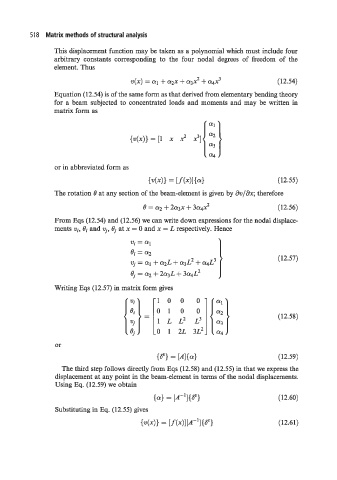Page 537 - Aircraft Stuctures for Engineering Student
P. 537
51 8 Matrix methods of structural analysis
This displacement function may be taken as a polynomial which must include four
arbitrary constants corresponding to the four nodal degrees of freedom of the
element. Thus
v(x) = a1 + Q2X + a32 + a4x3 (12.54)
Equation (12.54) is of the same form as that derived from elementary bending theory
for a beam subjected to concentrated loads and moments and may be written in
matrix form as
or in abbreviated form as
{V(X>) = [f(x>1{4 (12.55)
The rotation 8 at any section of the beam-element is given by av/ax; therefore
+
e = a2 + 2a3~ 3a4x2 (12.56)
From Eqs (12.54) and (12.56) we can write down expressions for the nodal displace-
ments vi, Bi and vj, 0, at x = 0 and x = L respectively. Hence
vi = a1
ei = a2
(12.57)
vj = a1 + a2L + a3L2 + a4L3
e, = a2 + 2a3L + 3a4L2
Writing Eqs (12.57) in matrix form gives
10 0
(12.58)
1 L L2
or
(0 = [-4l{a) (12.59)
The third step follows directly from Eqs (12.58) and (12.55) in that we express the
displacement at any point in the beam-element in terms of the nodal displacements.
Using Eq. (12.59) we obtain
{a> = [-4-11{0 (12.60)
Substituting in Eq. (12.55) gives

